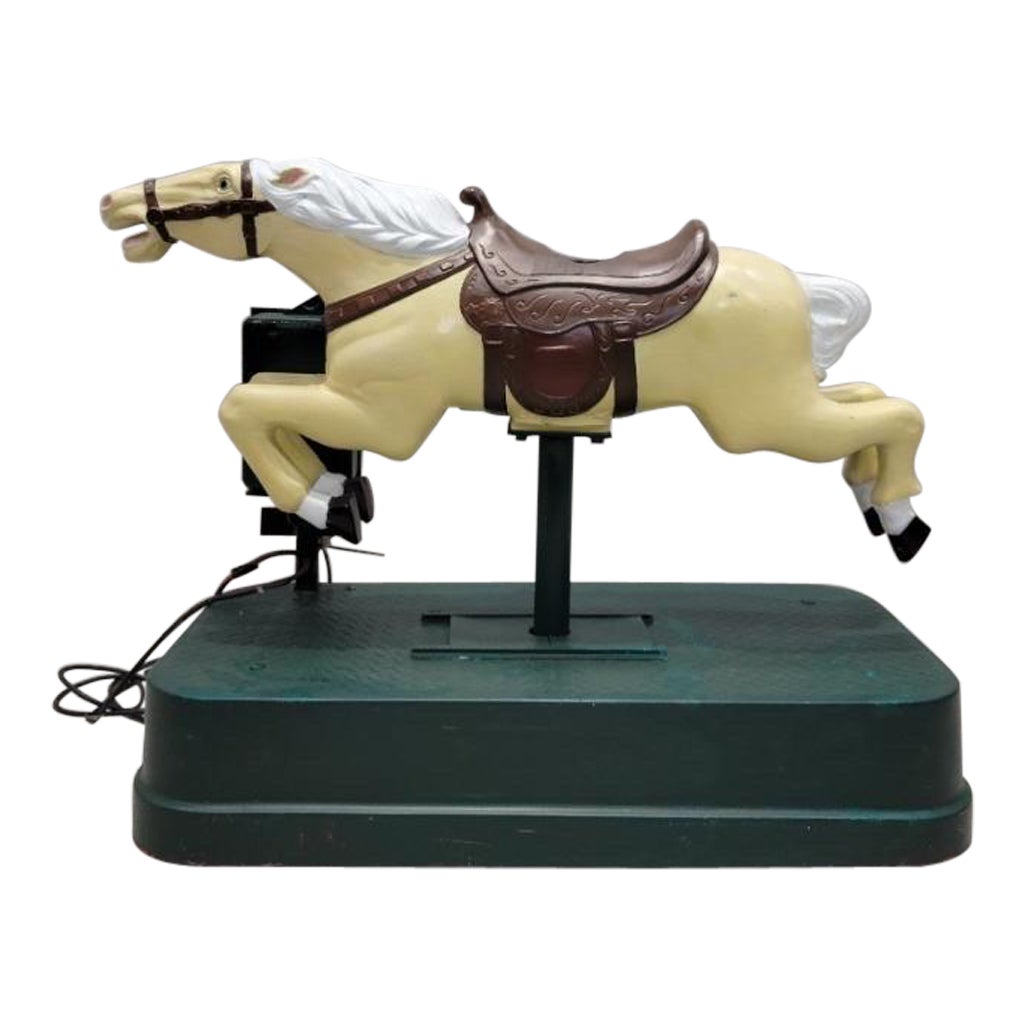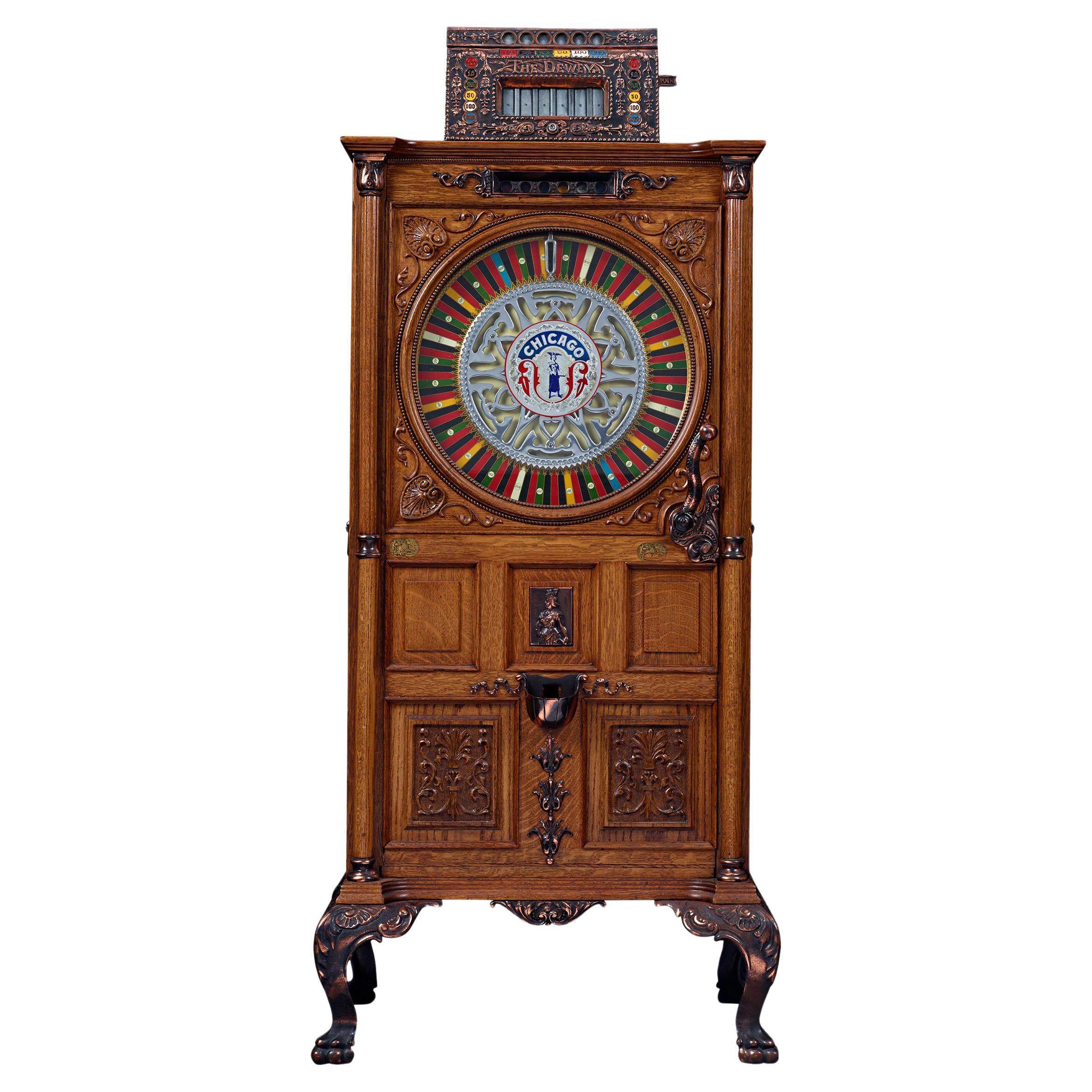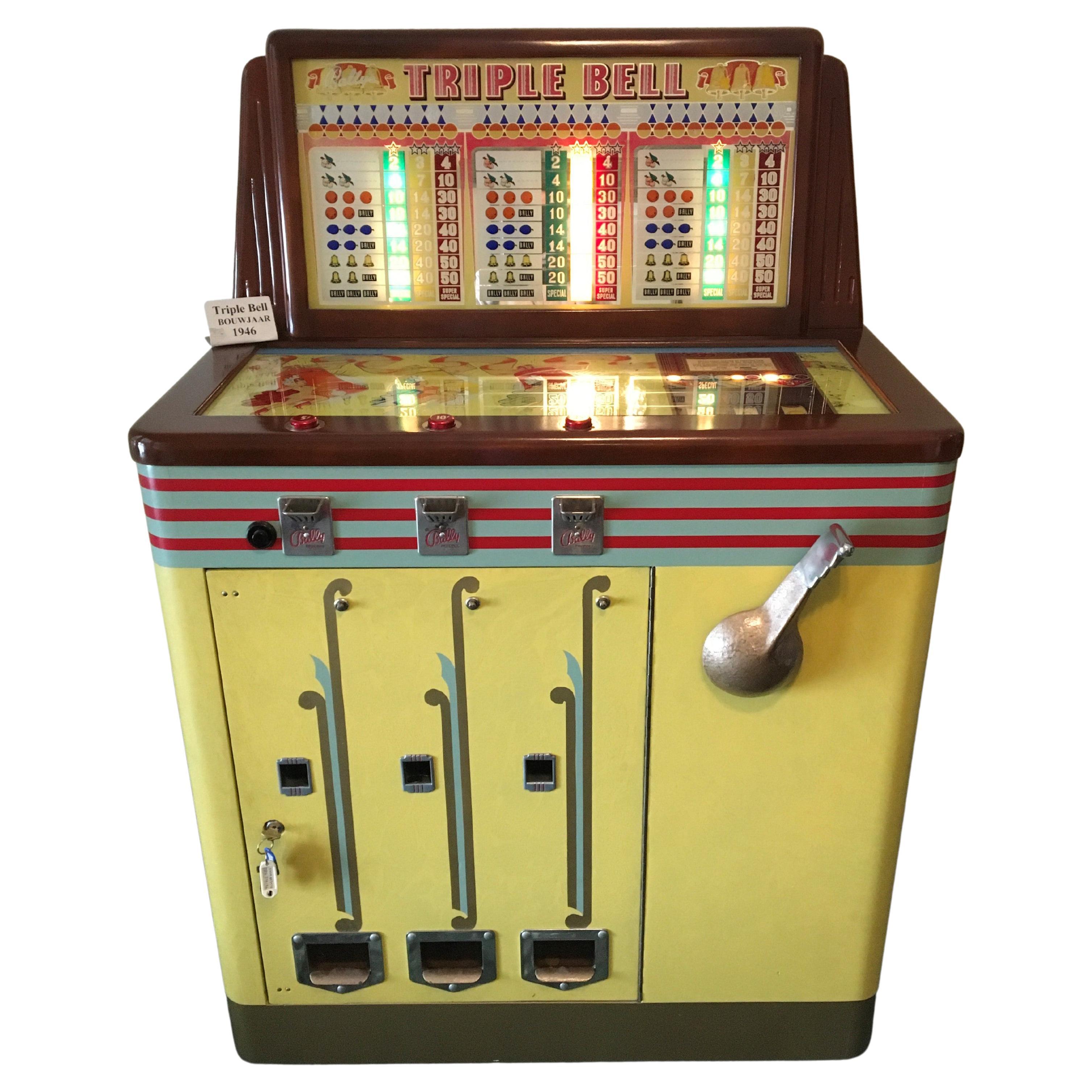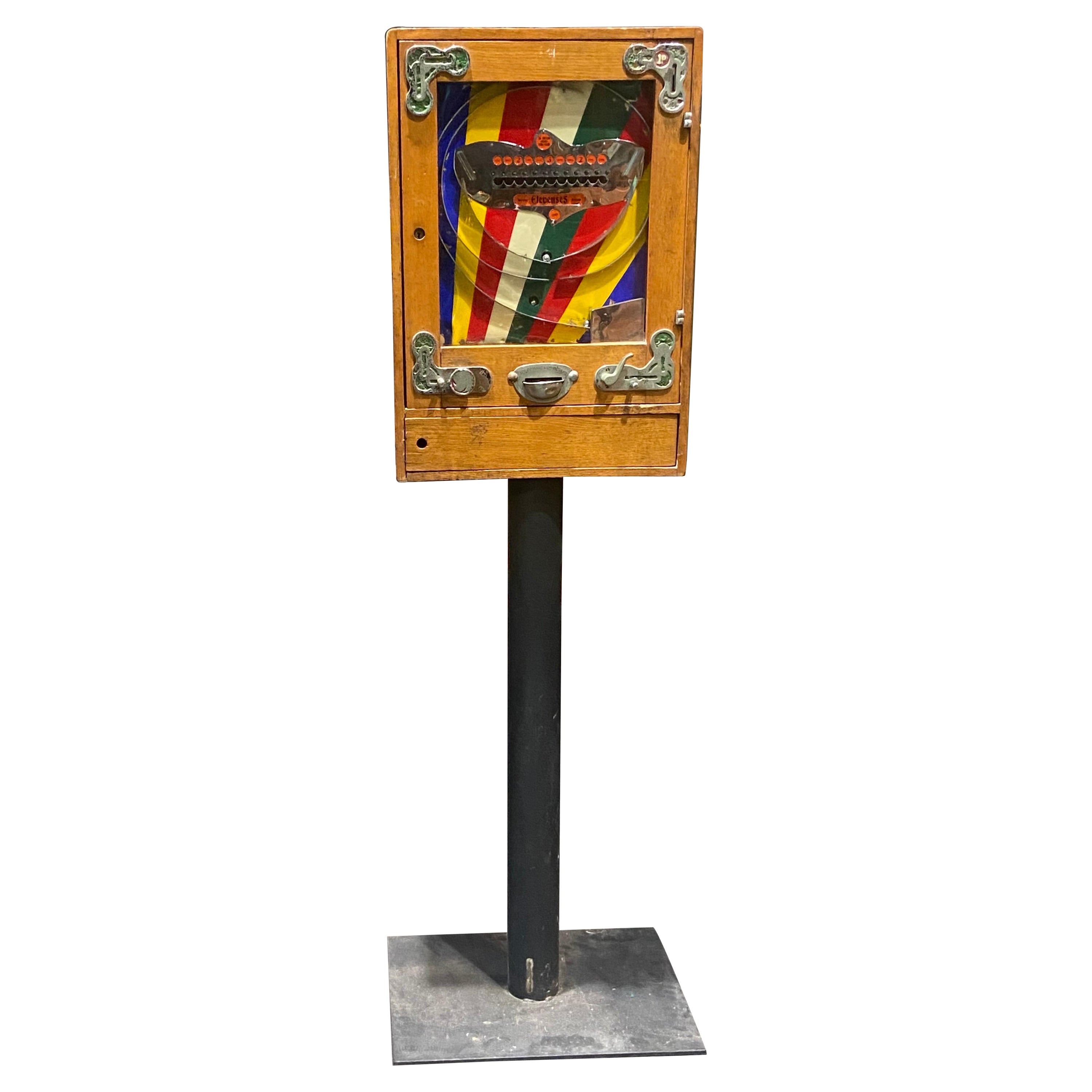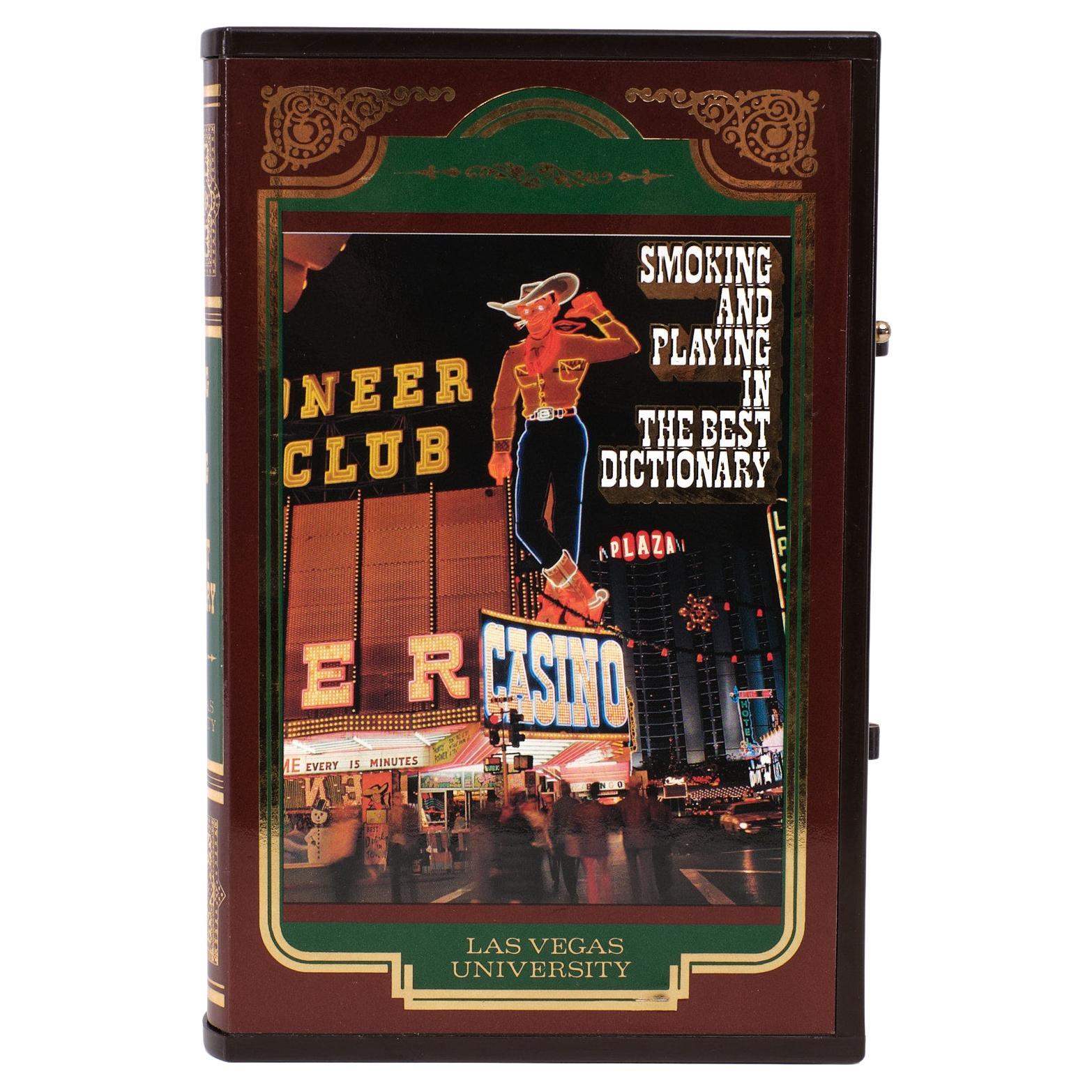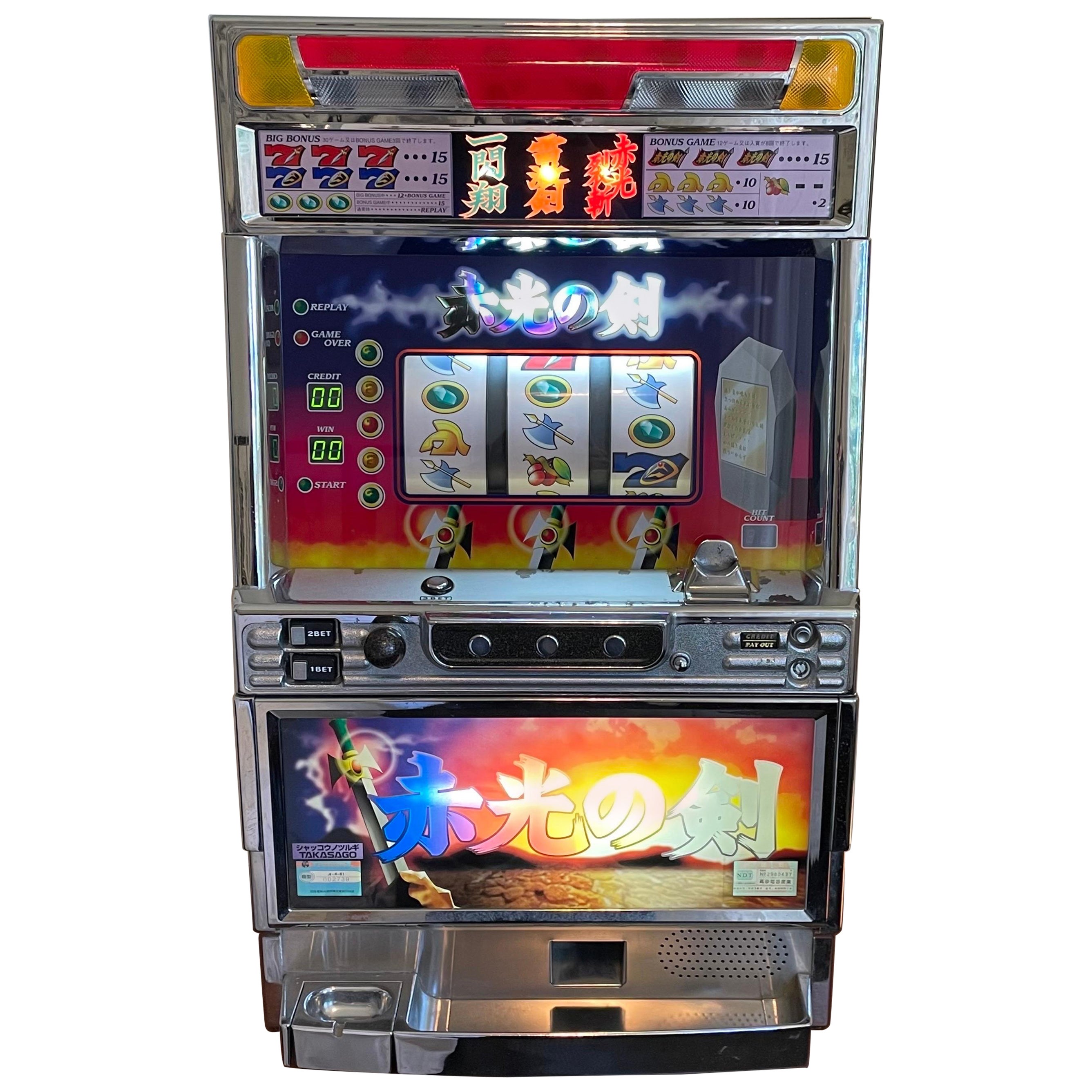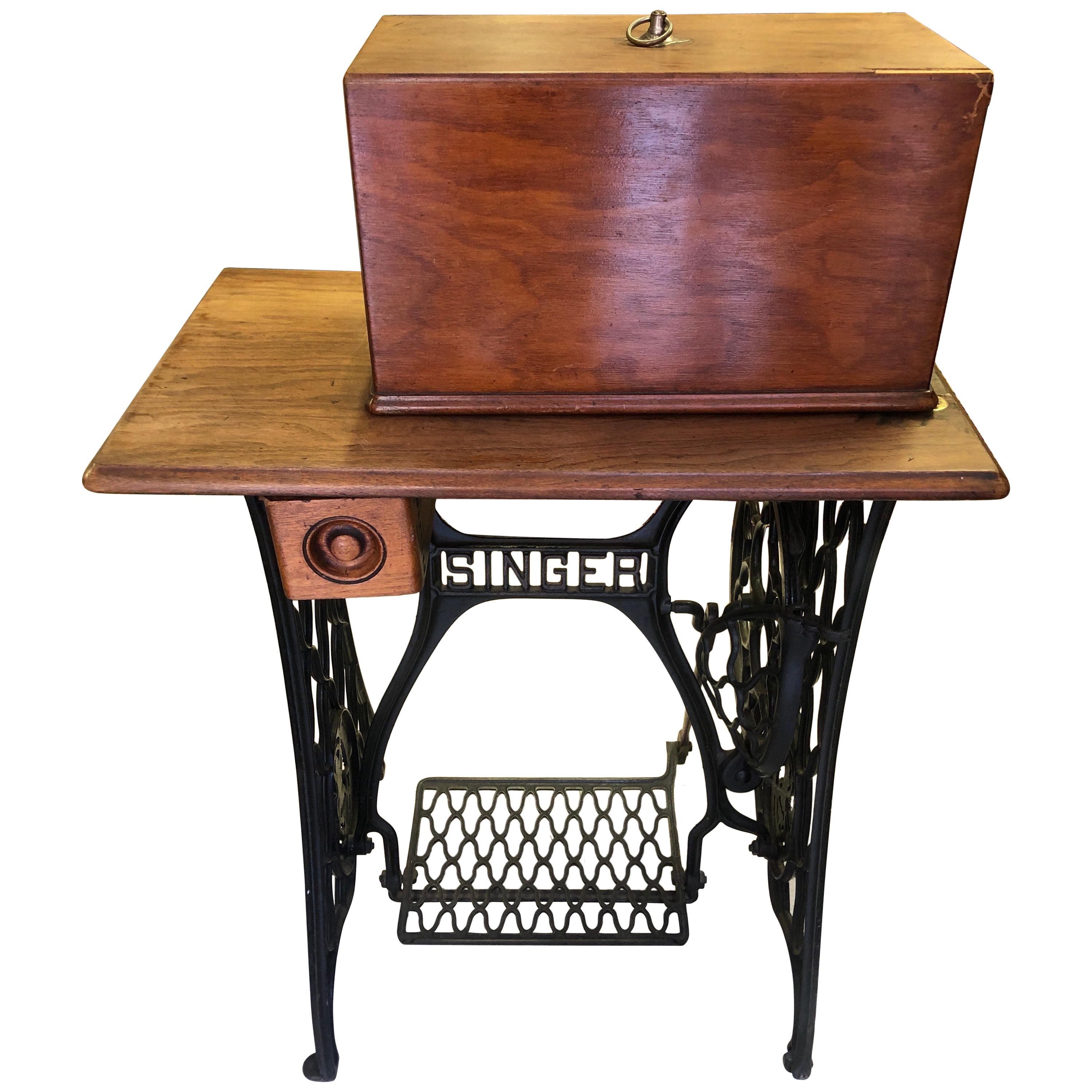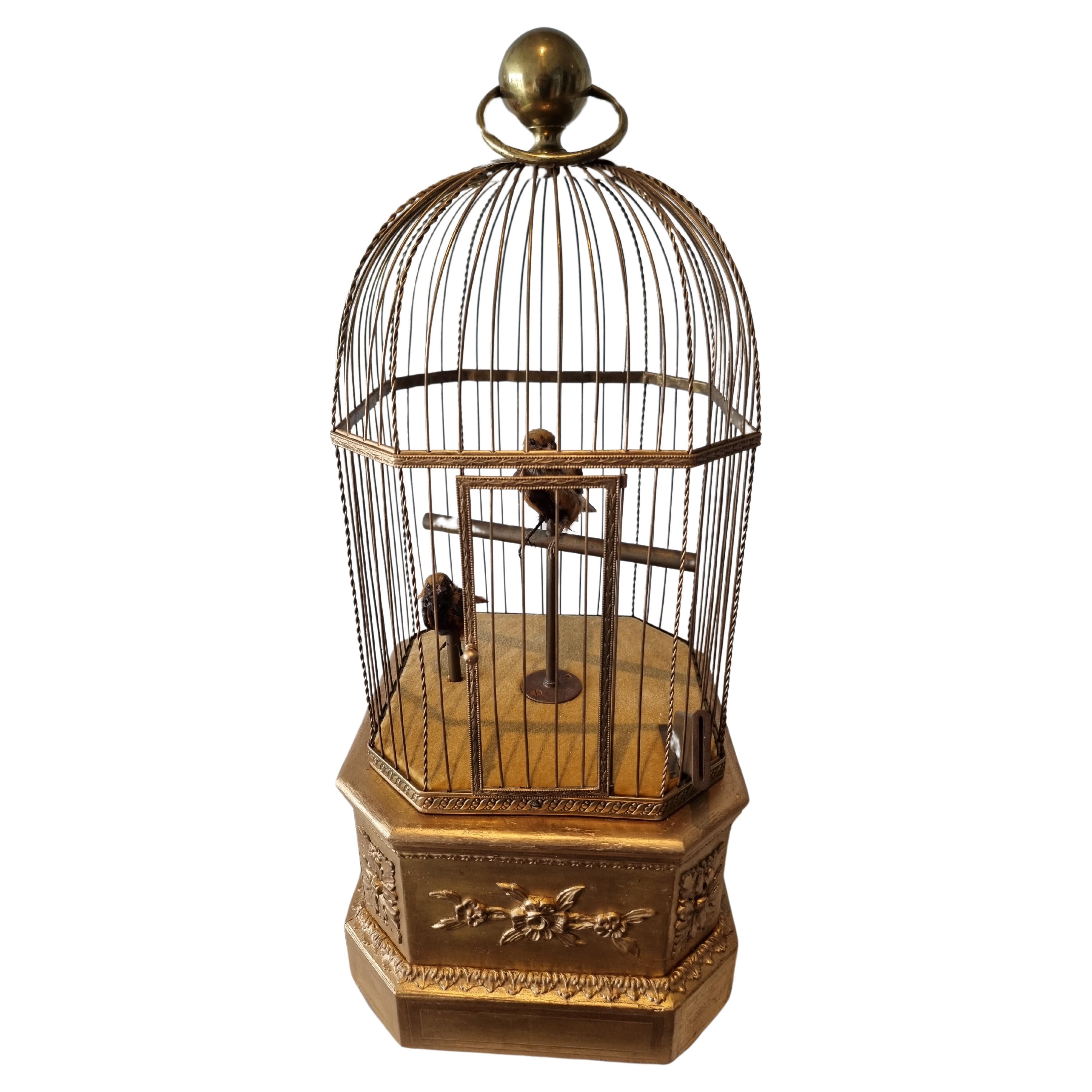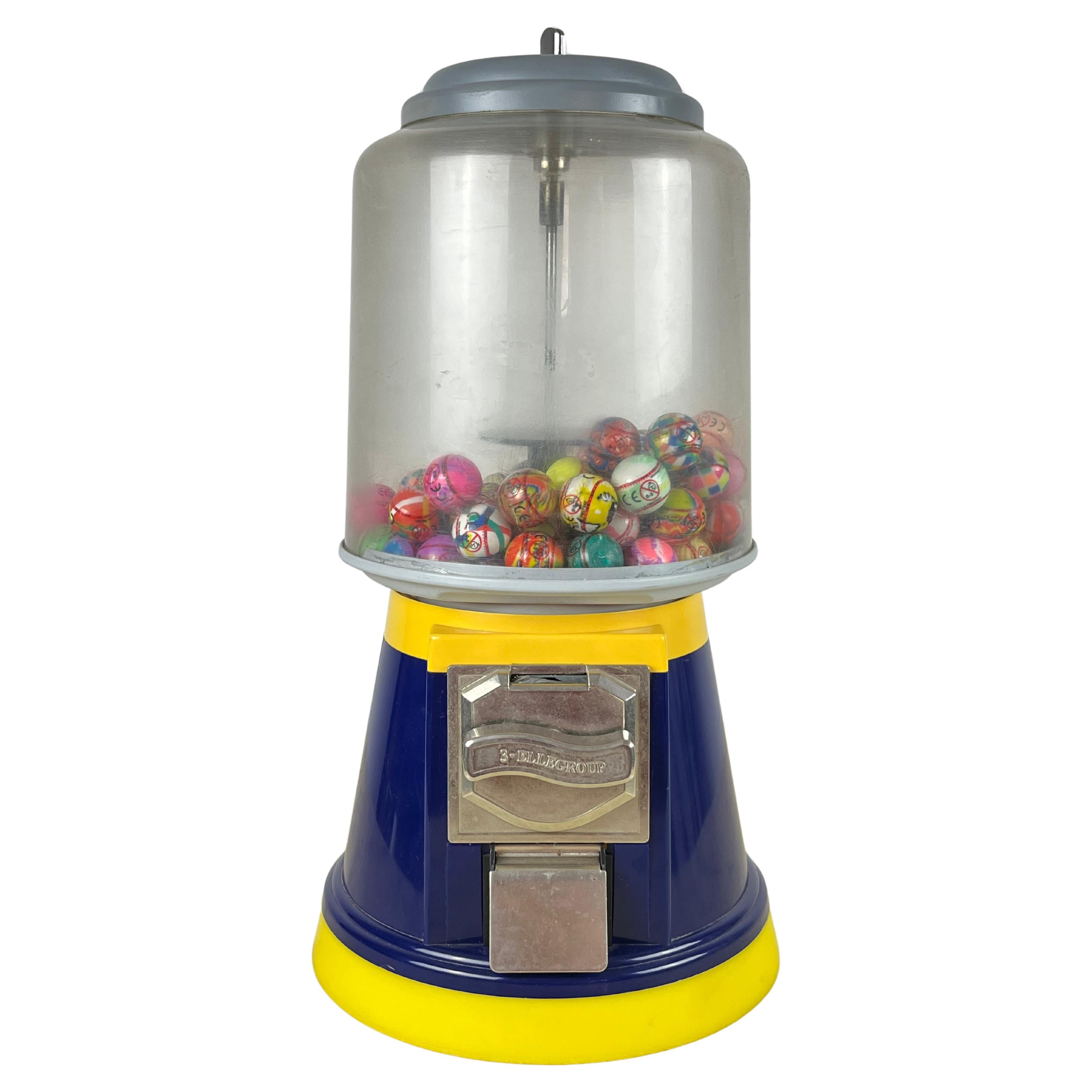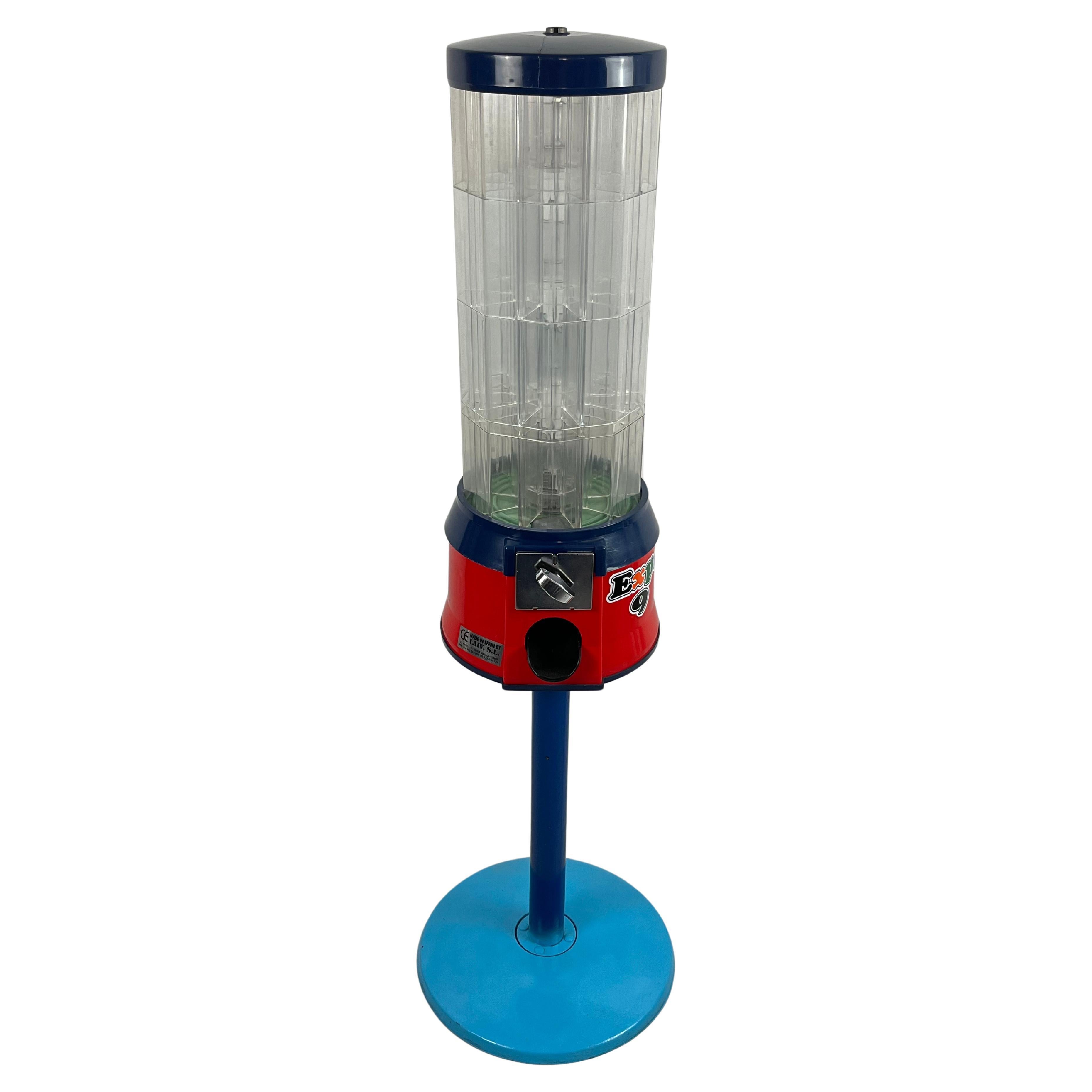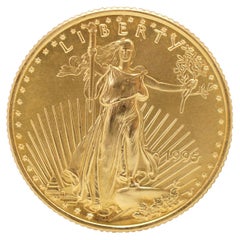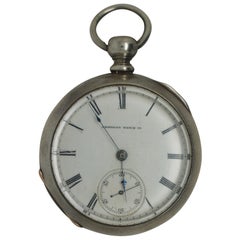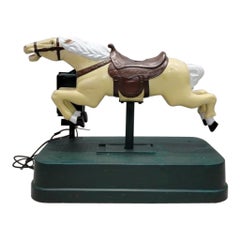
1982 IGT Draw Poker Coin Operated Slot Machine on Base
View Similar Items
Want more images or videos?
Request additional images or videos from the seller
1 of 12
1982 IGT Draw Poker Coin Operated Slot Machine on Base
About the Item
- Dimensions:Height: 59.5 in (151.13 cm)Width: 20.5 in (52.07 cm)Depth: 24 in (60.96 cm)
- Style:American Classical (In the Style Of)
- Materials and Techniques:
- Period:1980-1989
- Date of Manufacture:1982
- Condition:Wear consistent with age and use. Good overall, not tested, no power. We were not able to get the machine to turn on, we believe there is a short in the power cord. No lock, machine very clean inside. Case has some wear and missing veneer. See pictures.
- Seller Location:Dayton, OH
- Reference Number:Seller: 255461stDibs: LU5343220890322
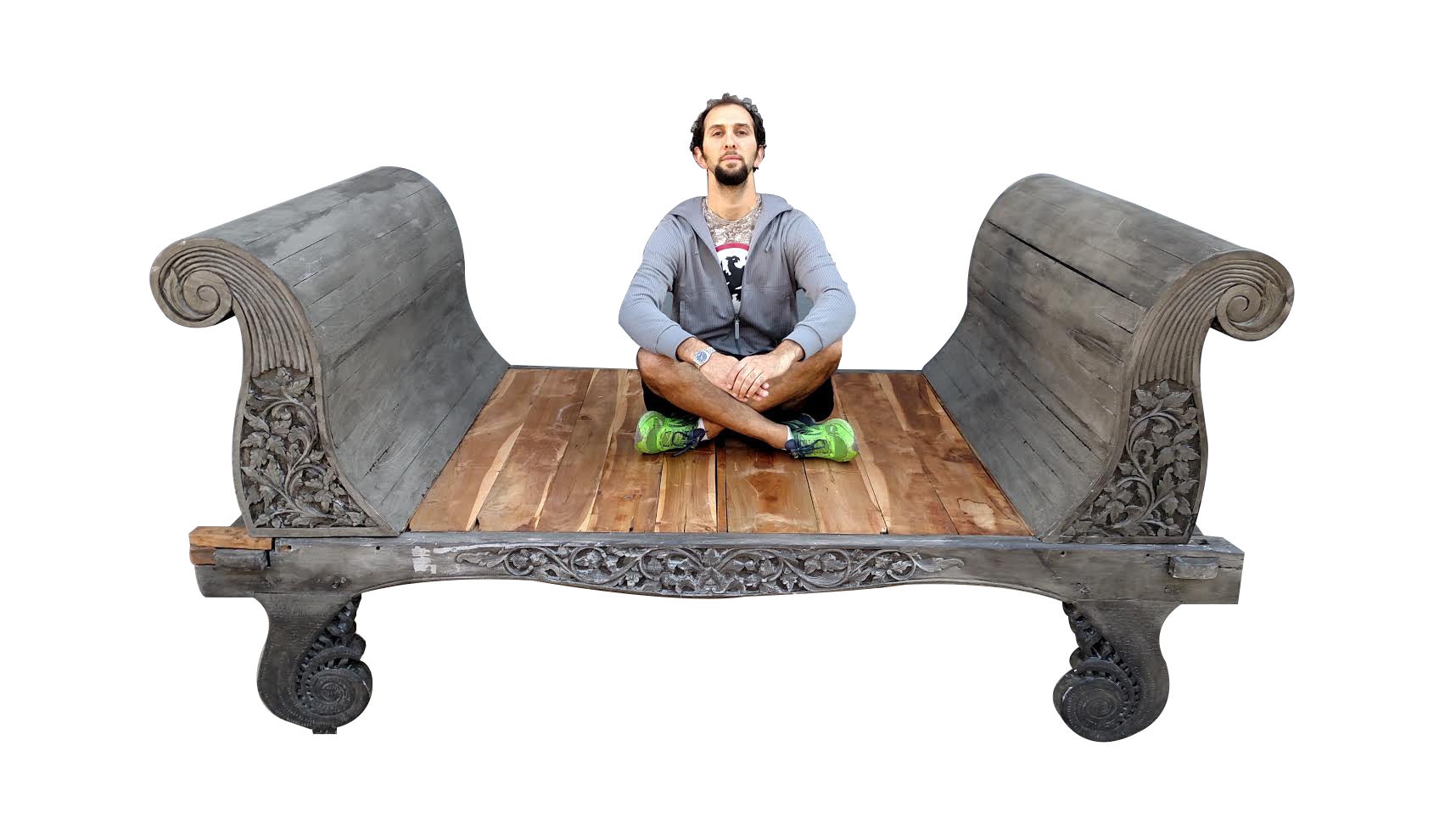
About the Seller
4.9
Platinum Seller
These expertly vetted sellers are 1stDibs' most experienced sellers and are rated highest by our customers.
Established in 2010
1stDibs seller since 2020
1,123 sales on 1stDibs
More From This SellerView All
- 1995 American Liberty Eagle 1/4 oz 22K Fine $10 Gold Coin US Currency 8.5gLocated in Dayton, OHVintage 1995 United States of America $10 coin made of 1/4 oz fine gold. Obverse: Lady Liberty walks toward the viewer with a torch and olive branch in her hands, across a landscape ...Category
1990s American Classical Historical Memorabilia
MaterialsGold
$940 Sale Price20% Off - Antique Brass Nautical Maritime Plunger Operated Yacht Boat Fog Horn 27"Located in Dayton, OHLate 19th - early 20th century brass plunger operated fog horn. Cylindrical body with horn attached to one side, pierced lid, and round, black finial on the plunger. Pair of brackets...Category
Antique Late 19th Century Nautical Objects
MaterialsBrass
$360 Sale Price20% Off - Antique 1870s American Waltham Key Wound 15J Pocket Coin Silver Watch 18SBy Waltham Watch CoLocated in Dayton, OHAntique late 1870’s American Watch Company key wound pocket watch. White porcelain face with black Roman numerals; second counting sub-dial with...Category
Antique 1870s Victorian Collectible Jewelry
MaterialsSilver
- 1949 Satchel Paige Cleveland Indians Autographed Team Signed BaseballLocated in Dayton, OHVintage Special League S48W horsehide baseball signed by members of the 1949 Cleveland Indians baseball team. Ball includes approximately 26 signatur...Category
Vintage 1940s American Classical Sports Equipment and Memorabilia
MaterialsLeather
$1,200 Sale Price20% Off - Antique 46 Star WMH Horstmann Company United States of America Flag 83"By HorstmannLocated in Dayton, OHAntique forty six star large wool American flag by Horstmann Company, circa 1908-1912. Horstmann firm was founded by William H. Horstmann (1785-1850), who had immigrated to Philadelphia from Germany. Horstmann bought out a local swordmaker in 1828 and thereafter entered the military goods field. The firm benefitted from the Civil War, becoming the largest military goods supplier in the nation by 1864. WILLIAM H. HORSTMANN & SONS, Manufacturers of Dress Trimmings and Military Goods. 5th & Cherry Streets, Philadelphia, PA. This house was founded, in 1815, by William H. Horstmann, a native of Cassel, in Germany. He had learned the trade of silk-weaving in France, and, emigrating to the United States in the above-mentioned year, established himself in Philadelphia as a manufacturer of fringe, laces and trimmings of various kinds. He married the daughter of Frederick Hoeckly, a German settler in Philadelphia, and also a manufacturer of fringe, coach-lace and tassels. He devised several improvements in this trade, especially by introducing varieties in the styles and patterns of this class of goods, there being at that time only two patterns used in the trade, which were known as the Jefferson pattern and the Monroe pattern. In 1824, he introduced into this country from Germany the use of plaiting or braiding machines, and about the same time he was the first to introduce into this country the use of the Jacquard loom, for weaving patterns in textile fabrics. His location was in the first instance at No. 50 North Third street, but within a short time he removed to a store next to the Harp and Crown tavern, afterwards known as the City hotel, and continued his business within a short distance of this point for many years. In 1828, he commenced the manufacture of military trimmings as a special department, and this branch has grown to most important proportions, Horstmann's military goods being in demand throughout time country. The firm have also executed large Government contracts in this line for the War and Navy Departments. In 1831, he established a branch house in New York city, and about the same time erected a factory at the corner of Germantown road and Columbia avenue. The factory was continued here until time erection of the extensive building at Fifth and Cherry streets, where the works, salesrooms and offices of time firm now are. This massive structure is six stories high, and extends 140 feet on Fifth street and 200 on Cherry street, and reaches back to Race street. The separate departments into which the business is divided are thirty in number. More than 1000 distinct looms and machines are in use in the building, many of them very costly and some invented and used exclusively by this firm, the motive power being supplied by a steam engine of fifty horse power. The area covered by the works is about 11,000 square feet. Time number of hands employed is very large, about 500. When the erection of a vast factory at this point was first proposed, a strong opposition was made by time holders of the neighboring property. The ancient German Lutheran Church and burying ground, since removed, stood opposite the site, and a bill was introduced into the Legislature to forbid the use of a steam engine within 100 yards of any place of worship. The interests which such a bill would have affected injuriously, especially those of several newspapers, roused a strong opposition to it, and it failed to become a law. In 1845, William H. Horstmann, the founder of the house, retired from the business, and his two sons, William and Sigmund, assumed the management and it was under their direction that the new building, above described, was erected. The goods produced by this house are of almost endless extent and variety. They include goods woven from all the various textile fibres—cotton, wool, silk, etc.—in every style, color and pattern, and are used for an infinite number of purposes. Narrow woven goods are time staple production, made up into material for dresses for both sexes, for use in daily life, and for regalia for ""societies;"" for the costumes of the stage, the upholstering of houses and of carriages, the uniforms of soldiers, together with equipments for the same, and for funeral purposes. The raw material used in the manufacture is to a great extent very costly, and their store rooms often hold as much as $200,000 worth of goods in an unworked state. There are two rooms devoted to power looms in the factory, one for coach lace and one for other styles of weaving, in which about 250 of these machines are constantly running. The braiding machines in the coach lace room are very noteworthy. The cord to be covered with braid is drawn through an opening in time middle of a flat, circular, metallic plate, about 15 inches across. Up to a point on this cord, about a foot above the plate, the threads of the braiding material converge, like the ribs of a tent-roof, and there weave in and out and out and in, as the coating of braid grows, and time covered cord rises and is wound away above. The weaving is accomplished by the motion of the spools below that carry the different threads of the braid. These spools stand in uprights, which are carried round and amongst each other in curved slots in the above-mentioned broad metallic plate. All but two of these spools run in and out among each other, with a swift, easy and intricate motion, mind so rapid that time eye can hardly follow it, while one or two special spools run steadily round and round among time twisting spools with the most extreme swiftness. Many other machines, displaying equally ingenious mechanism, are used in the factory. The various details of equipment manufactured and supplied by this house are also important, both for their number and the superior quality of the manufacture. The one article of swords may be taken as an instance. This trade grew naturally and immediately out of the established army and navy goods department of the works, it being necessary that the sword itself should be furnished together with the sword-belt and other trappings all complete. Every part of the sword and trappings, with the exception of the blade, is made on the premises. The blades are almost all imported from the ancient German sword-blade emporium of Solingen, where, it is said, swords have been made ever since the year 1147, when Count Adolphus of Berg brought home from the East and established there the business of forging Damascus blades. There is in this department a stock of some thousands of blades, of many different patterns and sizes, ready to be set and finished. Any style or sword can be had from this warehouse, from the plainest kind up to a presentation sword...Category
Vintage 1910s American Classical Political and Patriotic Memorabilia
MaterialsWool
$1,440 Sale Price20% Off - Antique Articulating Teddy Bear Driving Wagon Platform Pull Toy AmericanaLocated in Dayton, OHAntique wheeled platform articulating pull toy featuring a teddy bear stuffed animal seated in a red white and blue wagon with arms that move up and down a...Category
Early 20th Century American Classical Toys
MaterialsMohair, Hardwood
$468 Sale Price20% Off
You May Also Like
- Vintage Coin Operated Carousel Horse RideLocated in Chicago, ILVintage Coin Operated Carousel Horse Ride Classic American Vintage 25 Cent Coin Operated Carousel Horse Children's Ride By Amusement Equipment Mfg. Ltd. Eldon, MO All Original, Operational When Plugged in, Not Set for Coin Rides...Category
Mid-20th Century American American Classical Toys and Dolls
MaterialsMetal
- The Mills Chicago Upright Slot MachineBy Mills Novelty CompanyLocated in New Orleans, LAThis impressive Chicago upright coin-operated slot machine was built by the leader of the slot machine movement in Chicago and around the world, the Mills Novelty Company. Manufactur...Category
20th Century American Games
MaterialsNickel
- 1930’s Mills Novelty Horsehead Bonus Slot MachineBy Mills Novelty CompanyLocated in Oakland, CAThis 25-cent Mills Novelty Horsehead Slot Machine from around 1937, produced by the Mills Novelty Company in Chicago, Illinois, is a charming relic of the Art Deco era. Despite showi...Category
Vintage 1930s American Art Deco Sports Equipment and Memorabilia
MaterialsMetal
- Bally Triple Bell Console Slot Machine Game, 1946By BallyLocated in Antwerp, BE1946 Bally Manufacturing Co. - Triple bell - Console slot machine - one-armed Bandit. This Art Deco vending machine that we sell was restorated as well on the inside as outside. The outside looks great by his design and colors and with the majorettes - cheerleaders on the glass - it even has the looks of a jukebox. This large jackpot machine was repainted in the original colors and is an eyecatcher to place in your interior. The inside was left original and checked completely. Original technical scheme is even still inside. The wooden frame is also still in great condition. This Art Deco slot machine is amended for use in Europe ( 220 -240 V ) It can be used with 0.05 + 0.10 + 0.20 eurocents. At a winning fruit combination he pays out ! So hopefully you win the jackpot ! This machine is on wheels so easy to move. All the original keys are included. Electricity has been adjusted to 220 - 240 Volt. This vintage slot machine...Category
Mid-20th Century American Art Deco Games
MaterialsMetal
- Vintage Ball Cascade Bryan's Elevenses Allwin Penny Slot MachineLocated in Sofia, BGBar game called the ball cascade, mechanical. Works with 1penny coins. Bryan's Elevenses oak and metal - 1950. Presented on a non-original metal pedestal, height total: 156 cm. H...Category
Mid-20th Century English Games
MaterialsMetal
- Piezo Electric table Gas Lighter with Draw Poker 1970 USALocated in Den Haag, NLCuriosity this Piezo Electric table Gas Lighter with Draw Poker . crazy combination . when i bought this game and open the Faux book the lighter lid op right away ,after bin in a bo...Category
Vintage 1970s American Mid-Century Modern Games
MaterialsPlastic
Recently Viewed
View AllMore Ways To Browse
Coin Operated
Coin Machine
Vintage Coin Machine
Vintage Coin Operated
Coin Operated Machines
Poker Machine
Christmas Ornaments
Ornaments Christmas
Revolutionary War Antique
Wwii Era
Vintage Gas
British Royal Arms
Vintage Christmas Collectibles
Sea Captains Furniture
Royal Coronation
Navy Officer
Antique Curiosities Framed Prints
Wwii German
